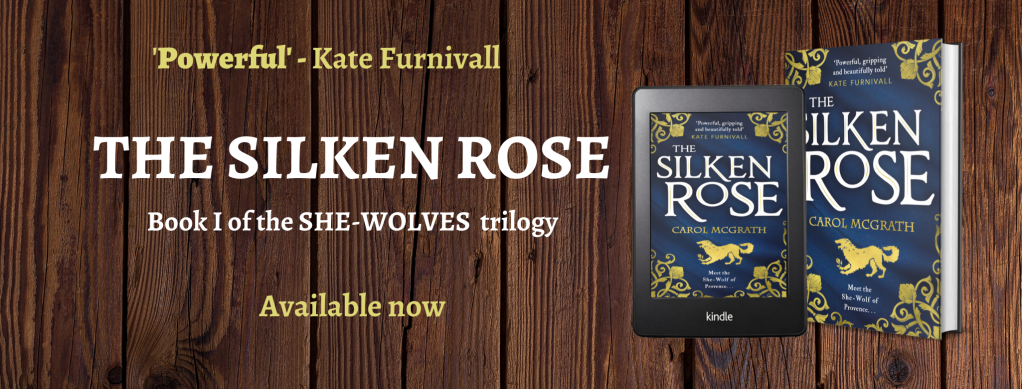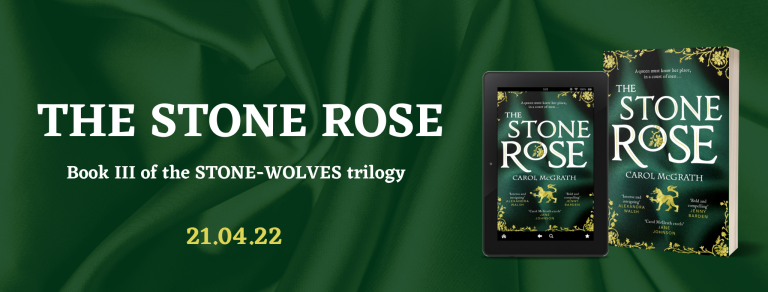Inspiration for Writing the She-Wolf Queen Trilogy – Carol McGrath

During the English High Middle Ages of the twelfth, thirteenth and fourteenth centuries there was a succession of foreign queen consorts. Some were honoured as the mothers of kings; others were also mothers of kings, but their reputations were tarnished in popular opinion for having too much influence on the politics of their day. These particular queen consorts earned the label ‘she-wolves’, a title popularised by later historians such as the Victorian writer, Agnes Strickland.
Strickland used the term for Ailenor of Provence, married to Henry III at thirteen years old, and accused in her own lifetime of nepotism: of overinfluencing the religious Henry (who nonetheless also adored parties and a peaceful life) by placing her uncles from Savoy in high positions within the Church and government.
‘She-wolf’ was also used to describe Eleanor of Castile, wed at only thirteen years to Edward I , a husband whom she adored and followed all over the land – even into war-torn Wales. Eleanor was accused by noblemen of greed and property acquisition by ‘determined’ – and sometimes unpopular – methods.
The final ‘she-wolf’ was Isabella of France, married at just twelve years old, who usurped her husband, Edward II, almost two decades later. She and her ally Mortimer ruled as regent for her son for five years. This is the stuff of Game of Thrones for real; who could resist such thrilling material to work with?
I was especially drawn to these three queen consorts because, with the exception of Isabella, their stories are rarely told in fiction. I also liked the synchronicity of mother-in-law, mother-in-law and daughter-in-law as concepts within the novels. These were characters worth bringing to life. Women, even medieval queens, tend to be only touched upon in primary source material. I felt my mission was to excavate the stories hidden within the source material, discover everything I could about their world, and animate their lives fully as possible in fiction, using the white spaces in-between that are not explored by historians.
My aim overall is to create an engaging story with characters whose fictional lives a reader wants to follow, to show a reader what these lives may have been and, importantly, to illustrate how these women used their queenly power to create impact on their world. Where an historical record exists, I have respected it, but as a writer of historical fiction, the joy for me has been creating heroines and thrilling tales that, while keeping to the facts, are all written to appeal to the modern reader. This was an edgy period with its own fascinating moral compass and, as such, gripping.
The popularity of Arthurian legend during these centuries intrigued me. The era was famously the Age of Chivalry’, and I weave legend into the fabric of the narratives. The twelfth, thirteenth and fourteenth centuries were famous for aspirational castle- and cathedral-building. Manor houses with beautiful, symbolic gardens existed all over the land. The medieval people adored gardens and orchards; not just for food production, herbs and fruits, but also for their flowers, such as roses and lilies. Also famous was the magnificent Opus Anglicanum embroidery: English embroidery worked with gold and silver threads and decorated with jewels for the creation of garments, hangings and church embroidery of fabulous value and beauty. It was for good reason that the thirteenth century is known as ‘the Magnificent Thirteenth Century’. This era saw stonecarving of exceptional quality and beauty gracing fortresses, place of worship and landscapes.
Each novel has a counterpoint heroine to provide further depth to the novels. For example, in The Silken Rose, a story of dangerous high politics, Rosalind, an embroideress is introduced. Her romantic story intersects with Queen Ailenor’s narrative. An herbalist, Olwen, is important in Eleanor of Castile’s story, The Damask Rose. Finally, in The Stone Rose, a female stonemason designs Queen Isabella’s tomb. Amazingly, this last is historical fact. Introducing the secondary stories enriches both my own and a reader’s experience, drawing readers further into an ‘othered’ world, within which, I hope they lose themselves.
The Silken Rose, The Damask Rose and The Stone Rose are true stories, if a little embellished; of real queens who made a mark on English medieval history. As queens and as women they showed intelligence, independence and great determination during an age entirely dominated by male power. That, above all, is my inspiration for writing this trilogy.
They called her the She-Wolf From Provence. She'd shape the destiny of England ...
Fans of Alison Weir, Anne O'Brien and Philippa Gregory, will devour this compelling new novel, starring one of English history's most fierce and courageous forgotten heroines!
'Powerful, gripping and beautifully told' - Kate Furnivall, author of The Liberation
'A feast for the senses and highly recommended' - Deborah Swift, author of Pleasing Mr Pepys
'Well-researched . . . Fascinating' - Joanna Courtney
READERS LOVE THE SILKEN ROSE!
***** 'Stunning start to a new series of She-Wolf Queens'
***** 'Spectacular . . . I will recommend this first part of her new trilogy to everyone'
***** 'Fabulous . . . A lovely, highly researched tale'
***** 'Exceptionally well-written . . . From the first page I was totally caught up in the story'
1236. Ailenor of Provence, cultured and intelligent, is only thirteen when she meets her new husband, Henry III of England. A foreign and friendless princess in a strange land she is determined to please him. And she knows that when the times comes she must provide an heir, to secure the throne against those who would snatch it away.
Rosalind, a commoner skilled in the arts of needlework and embroidery, catches the young queen's attention and a friendship blossoms. But she is unprepared for the dangerous ramifications of winning the queen's favour ...
As closeness, and soon love, develops between Ailenor and Henry, so too does her influence on her husband and her power at court. As France and Wales provide constant threat, and England's barons increasingly resent her influence, Ailenor must learn to be ruthless. Who should she encourage her husband to favour? Who can she trust?
Caught in a web of treachery and deceit, her choices will define the fate of England. To protect her close friends, and her beloved children, Ailenor, the She-Wolf from Provence, would do, and endure, anything ...
For news, updates and exclusive material, sign up to Carol’s newsletter here: http://carolcmcgrath.co.uk/newsletter-sign-up/
Twitter: @CarolMcGrath







